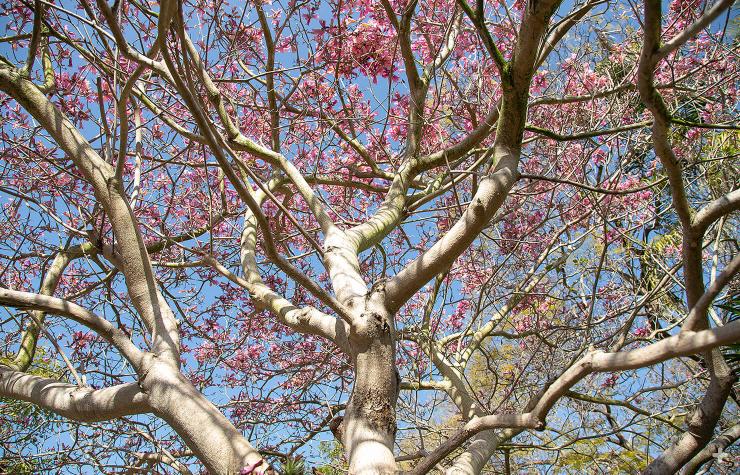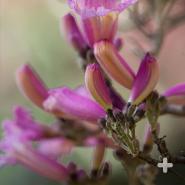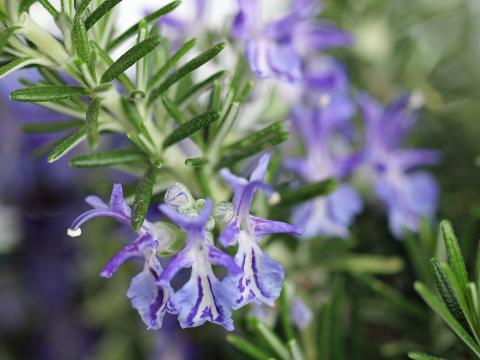Pink Trumpet Tree
- Division: Magnoliophyta
- Class: Asterids
- Order: Lamiales
- Family: Bignoniaceae
- Genus: Handroanthus
- Species: heptaphyllus; impetiginosus
OVERVIEW
With its leafless crown studded with thousands of vivid pink, trumpet-shaped flowers—bursting into spectacular bloom during March and April in Southern California—the pink trumpet tree makes an indelible first impression. Its eye-catching flowers are short-lived, but they are replaced by a crown of palmate compound leaves, each with five to six dark green leaflets, providing welcome shade in late spring and summer. The deciduous tree drops its leaves during fall and winter, in preparation for its next spectacular springtime flower show.
The tree is endemic to South America and has an extensive range from Argentina to Mexico, however it was not widely introduced in Southern California until the 1970s. Because of their head-turning appearance when in bloom, pink trumpet trees were chosen for use in the landscaping around the Walt Disney Concert Hall in Los Angeles—and both the Los Angeles County Arboretum and Botanic Garden and Santa Barbara’s Alice Keck Park Garden feature large numbers of this showy tree.
CHARACTERISTICS
The pink trumpet tree is a member of the Bignoniaceae family, which includes many other trees with spectacular floral displays—including jacaranda, African tulip tree, and catalpa. The pink trumpet tree’s flowers are considered “perfect,” having both male and female parts. After flowering, the tree produces brown seed pods that are about 3 inches (7.6 centimeters) long, containing small winged seeds. Pink trumpet tree branches are resistant to breakage, making them ideal shade trees for windy areas.
GROWTH
While pink trumpet trees are available from nurseries, they can also be grown from seed or cuttings. The tree grows about 2 feet per year, and trees grown from seed can take between 3 and 20 years to first flower. When mature, the pink trumpet tree can reach an average height of 20 to 30 feet, with an oval-shaped, open crown that spreads 15 to 25 feet.
The pink trumpet tree requires full sun, but it requires minimal water and is highly drought tolerant. It requires well-drained soil and will grow in a wide range of soil types, from sand and clay to acidic and alkaline soils. Staking is required to help young trees grow. Structural pruning is also required when the tree is young, to maintain its long-term shape—cutting back drooping low branches to encourage high arching branches. This tree is ideal for use in residential and commercial landscaping applications, because its roots are not invasive.
USES
In addition to its use in both residential and commercial landscaping, to provide shade and seasonal color, the pink trumpet tree is sometimes harvested in South America to provide an extremely durable wood for construction. Other Handroanthus species are also used to produce this honey-colored, sawn wood, which is marketed as ipê. This dense hardwood carries the same fire rating as concrete and steel, and is often used in flooring and decking. Some types of ipê now bring high prices in Brazil, and conservationists have expressed concern about the sustainability of harvesting ipê—citing illegal logging in some areas and the fact that mature trees are hard to find, which could lead to deforestation. Consumers buying ipê should look for the Forest Stewardship Council’s stamp, indicating that FSC-certified wood is sustainably grown in managed forests.
An herbal tea called pau d'arco is made from the inner bark of Handroanthus impetiginosus. The tea is used in traditional medicine in South America, and it is sold in health food stores.
OUR COLLECTION
Pink trumpet trees can be found at both the Zoo and Safari Park.
















